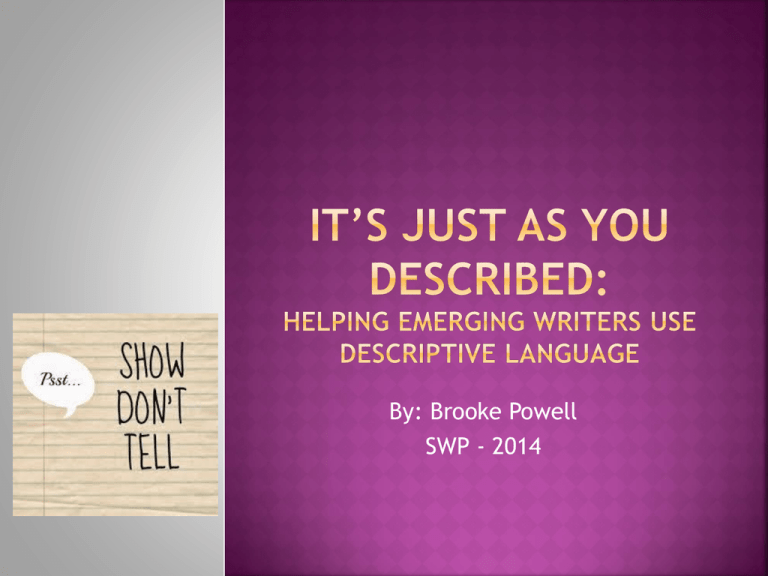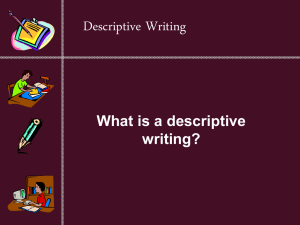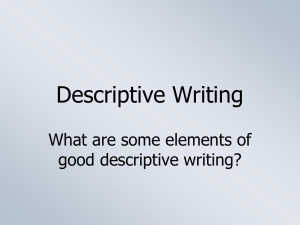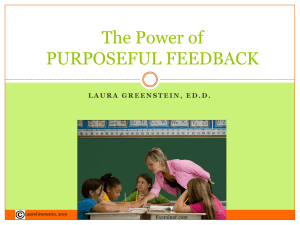Staying on Topic, using descriptive language and adding voice
advertisement

By: Brooke Powell SWP - 2014 Agenda for the Workshop: Introduction to roadblock Example writings at beginning of year How can descriptive writing be taught? Creating anchor charts/ Why are they important? Group discussions/Share time Example of descriptive language/ Partner Activity Mentor Text – Owl Moon by Jane Yolen – Group Activities Word Cloud Activity Example writing at end of year Practice/Slice of Life I have identified my instructional roadblock as being able to have my Kindergarten students write more without being repetitive and sounding dull by incorporating the use of descriptive language into their writings. My goal In teaching them how to use descriptive language appropriately is that their writings will be more interesting and full of details and it will encourage them to use new vocabulary words that they may have not known how to use before. “Good descriptive writing includes many vivid sensory details that paint a picture and appeals to all of the reader's senses of sight, hearing, touch, smell and taste when appropriate. Descriptive writing may also paint pictures of the feelings the person, place or thing invokes in the writer.” -Reading Rockets.org Google images Lines from children books with examples of great descriptive language Teaching Descriptive Language Effectively ***I will monitor students’ progress by having a rotating conferencing schedule so that I will be able to see their writings weekly to make sure they are adding descriptive language to their pieces.*** Google image Google image Google image Unpack Your Adjectives Song School House Rocks My Strategy Once my students have mastered writing simple sentences, I encourage them to add a little sparkle to their work. For example, if a student writes “The cat sits,” have them explain what the cat looks like, how it feels and where it sits. Continue by guiding them through the creation of a new sentence. For example: “The big cat sits happily on the chair.” This is a great activity to use when teaching my students how to add descriptive words. I model this activity with my students several times to help them understand and master the concept. Turn and talk with a partner at your table about the following questions: 1. Have you see that your students have struggled with incorporating the use of descriptive language in their writing? 2. If so , what are the trends you see in their writings? Ex; being repetitive etc. 3. Why do you think students struggle with adding descriptive language to their writing? 4. What strategies have you used to teach descriptive writing to your students in your classroom? First, let’s get it clear that the house is practically falling down, but for some reason that doesn’t make any difference to how beautiful it is. It’s made out of big chunks of yellowish stone, and has a steep roof, and is shaped like an L around a big courtyard with fat pebbles set in the ground. The short part of the L has a wide arched doorway and it used to be the stable, but now it’s the kitchen and it’s huge, with zigzag brick floors and big windows all across the front. Study Driven – Pg 58 • She put a negative and turned it into a positive • • • • • • • She used personification Word choice was positive Words are colorful and warm Words are specific and descriptive She was precise with her word choice Had an oxymoron in her writing “Learning new words helps them (students) to master new subject matter more quickly and solidifies their understanding of it. Reading and understanding more difficult texts and speech will be easier for children who have a good grasp of descriptive language.” -Leyla Norman, Demand Media Get out a piece of paper Listen to the first two minutes of the story Owl Moon by Jane Yolen After I stop I want you to create a picture of how you visualized Jane Yolen’s interpretation of what was read based on her use of descriptive language in the text Also write down the descriptive words that you hear that helped you to create a picture in your mind Book Flix Owl Moon Do we have any volunteers who would like to share their pictures? What words did you “hear” that helped you to create your picture in the first 2 minutes of Jane Yolen’s Owl Moon? This will engage students and they have the opportunity to help me create something that will be useful to them. It will also help me to assess if the students listened to the story and understand what descriptive language is. They can use this to create their own word clouds with other books that they read or about a writing topic that they are struggling to add descriptive language in. You have two different options You can choose to revise the writing below by adding descriptive language to make it sound better and to help create a picture in the reader’s mind OR you can write your own “slice of life” like Jane Yolen did in the story Owl Moon. If you choose this route then you need to write about an experience that you remember with an animal, pet or special person. Make sure to remember the tools we have learned about using descriptive language and make sure to incorporate those words into your writing! You have 15 minutes and then we will share I was nervous about meeting new classmates. Would they be nice to me? Would there be new kids? I found out that all of my classmates were nice. The new kids fit right in. I wondered what the teachers would be like to. I wondered if they would be mean. I wondered if they would like me. Click below to find a list of books that you can use in your classroom to help with this strategy Descriptive Writing Mentor Texts 1 More mentor texts “When students write from experience, they can breathe those specifics into their writing- dialect, odd smells, precise names of plants- that can animate even the most tired and tedious text.” ― Ralph Fletcher What a Writer Needs Excerpts from A Writer’s Notebook: Unlocking the Writer Within You By: Ralph Fletcher Resources Fletcher, Ralph. What a Writer Needs: Portsmouth, NH. Heinemann. 1993. Print Norman, Leyla. What Is the Importance of Children Using Descriptive Words in a Sentence?, n.d. Web. 10 June 2014. http://everydaylife.globalpost.com/importance-children-usingdescriptive-words-sentence-15948.html Ray, Katie Wood. Study Driven: Portsmouth, NH. Heinemann. 2006. Print “Reading Rockets.” Descriptive Writing Strategies, n.d. Web. 12 June 2014. http://www.readingrockets.org/strategies/descriptive_writing







